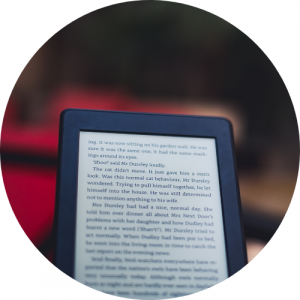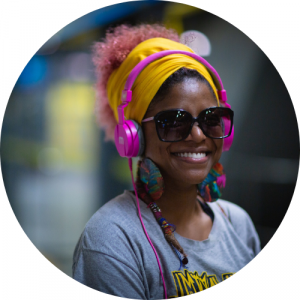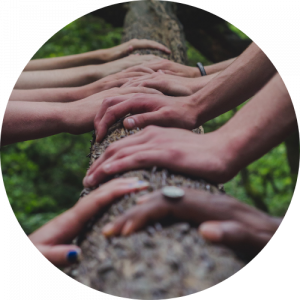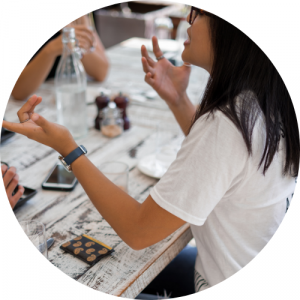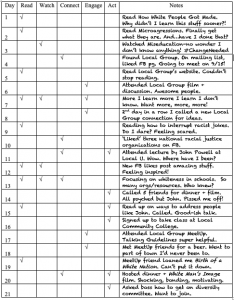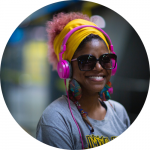21-Day Racial Equity Habit Building Challenge©

"There is no social-change fairy. There is only change made by the hands of individuals." – Winona LaDuke
© 2014 All Rights Reserved America & Moore, LLC
Fall 2022 Version: Recapturing Momentum, Building Community
In the year following George Floyd’s brutal murder, a racial reckoning swept the globe. Droves of white people new to antiracism stepped up. In year two, just as many Black people, Indigenous people, and other people of color predicted, momentum stagnated. What happened? Was becoming antiracist harder than white people expected? Did the pandemic play a role? What we do know is that as the movement to recalibrate white supremacy through book bans, policy rollbacks, and violence towards historically targeted groups flourished, the commitment to antiracism waned.
How do we get back on track? How do we simultaneously center our humanity and need to restore and keep the movement towards liberation going? When we burnout, white supremacy wins. We find working in groups, building community, sometimes just to break bread and be together, makes the work sustainable. Liberation work is collective work, relationship work after all.
Our 21-Day Challenge is meant to inspire and fuel. We encourage you to gather with fellow learners, old and new, and find new energy through your relationships. Change is hard. Small, persistent steps though, can yield powerful results. The goal is to keep going. Our hope is that on day 22, you won’t say, “Whew, that’s over!” you’ll say, “Wow, we’re on a roll!”
There's no denying we are deep into a chapter of historic change. In this era of global transformation, we are among those who are pushing for a world that centers everyone's humanity, excludes no one, moves away from a winner/loser approach, acknowledges and repairs harm, builds the skills to do that, and embraces truth telling, relationship, and belonging.
Choose one activity per day...
...to further your understanding of power, privilege, supremacy, oppression, and equity.
#BringItHome
If you have young people in your life, integrate these resources to share and have conversations around.
Stay Inspired
Create a Soundtrack-4-Justice playlist that fuels you and/or can serve as a conversation starter with people of all ages.
Shoulders We Stand On
Tap into the wisdom of justice educators and activists who've helped us get to where we are now. Here are just a few.
TEN Tips For Success
- Organizational leaders, jump to #7 for inspiration
- Individuals, start by choosing which tracking tool works for you.
- google doc version for on-the-go tracking
- printable PDF if you’re a paper person
- Check out our recommended Day #1 activity to help you think about the connection between comfort level and learning.
- Diversify your habits. The tracking chart encourages you to use resources across our many categories.
- Some resources are on subscription platforms. If you come upon a resource on a for-fee platform you don't have, just skip past it. We’ve loaded the challenge with free resources with that barrier in mind.
- You can do the challenge alone, though we strongly recommend doing it with friends and family, or organization-wide. Antiracism work is relationship work and this is a great tool to deepen relationships old and new.
- Click HERE to get inspired by seeing how institutions are adapting the challenge to meet their specific social justice focus
- Like our Facebook page. Use it to get ideas as well as share your 21-Day experience with the 21-Day community.
- Stay tuned for 21-Day swag and Moore!
- Repeat the plan annually! One-and-done's have no place in the ongoing process to create life, liberation, and justice for all.
If you want to stay connected, email 21daychallenge@theprivilegeinstitute.com. We'd love to know how it went for you and your group!
Thank you for taking on the challenge. We’ll be right here with you, challenging ourselves daily!
Peace and blessings,
The 21-Day Team
Dr. Eddie Moore, Jr., Debby Irving, Dr. Marguerite W. Penick, Jenni Oliver, Ashleigh Graham
Resources
Community Building, National Museum of African American History and Culture. Guides us on the importance of and how to build community while talking about race. 2022
Avoid Activist Burnout and Sustain Your Commitment to Community , Lesley University. Tips on how to combat helplessness and support each other through community work. 2022
Reclaiming Audre Lorde’s Radical Self-Care, Refinery 29. Using Lorde’s self-care work as a guide for those working on community justice issues. 5/2021
National Hispanic Heritage Month Is Incomplete Without Afro-Latino History, Time. In the United States, there are untold stories of unique Afro-Latino history-makers who were thrust into a racially segregated society. 9/2022
Queen Elizabeth II was the modern face of colonization. She doesn’t deserve the world’s exaltation in death, cleveland.com. While many are lamenting the death of a monarch, for many Indigenous people, she was the modern face of colonization. 9/2022
At the Announcement of Ambassador Gina Abercrombie-Winstanley as Chief Diversity and Inclusion Officer, The U.S. State Department. Secretary of State, Anthony Blinken, introduces Ambassador Gina Abercrombie-Winstanley as chief diversity and inclusion officer – the first in the department’s history. 4/2021
How racism shaped the Main Line — and American suburbs, The Philadelphia Inquirer. Examines the roots of systemic racism in America through institutions founded in Philadelphia. 4/2022
Ketanji Brown Jackson Makes Her Mark Early, Often as US Supreme Court Work Begins, Bloomberg. In her first two days, Jackson staked out positions in voting, environmental cases. 10/2022
Racism, whiteness, and burnout in antiracism movements: How white racial justice activists elevate burnout in racial justice activists of color in the United States, Sage Journals. This study is an attempt to address burnout for racial justice activists. 3/2019
Be Bold, The Players Tribune. Blake Bolden, the first African-American player to compete in the National Women's Hockey League, discusses her journey to becoming the first African-American, female NHL Scout. 3/2021
Settler Fragility: Why Settler Privilege Is So Hard to Talk About, Dina Gilio-Whitaker. Like white privilege, the author examines privilege based on colonialism and how U.S. citizens take pride in a country that was taken by force. Settler privilege and fragility examines the lack of critical consciousness about the U. S’s contradictory foundational structures and narratives. 11/2018
“The Story of How Humanity Fell in Love with Itself Once Again”, Lyla June Johnson. Johnson’s personal reflection of being of both European and Native descent and how she found love in herself. 2016
Two Spirits, One Heart, Five Genders, Duane Brayboy (Tosneoc Tuscarora) examines how European colonialism tried to erase the celebration of varied genders and LGBT individuals within Native tribes. 9/2018
Being Biracial in a Black and White World, Kya Cudjo. The author examines the topic of being ‘mixed race’ and what it means to have “mixed race people problems”. 7/2022
Racist Housing Practices From The 1930s Linked To Hotter Neighborhoods Today, NPR. Researchers find neighborhoods with higher temperatures are often the same ones subjected to discriminatory, race-based housing practices. 1/2020
In Jackson, Miss., a water crisis has revealed the racial costs of legacy infrastructure, Brookings Institute. Examining the parallels between racist infrastructure policies and the recent water crisis in Jackson, MS. Jackson is a city with one of the largest shares of Black people in America, in the Blackest state in the union. 3/2021
Why Black characters in 'Rings of Power' and 'Little Mermaid' make fantasy better, Equal Opportunity Today. Discusses the recent uproar over black characters and “white erasure” within fantasy media. 9/2022
Activists and historians from the 1960s see no progress in the 2020’s, NPR. Interviews with activists and witnesses of the anti-war movement and the civil rights struggle, who today are watching with dismay as the country is again torn asunder. 9/2022
House passes “Crown Act” or Creating a Respectful and Open World for Natural Hair, congress.gov. Congressional Act prohibiting discrimination based on an individual’s texture or style of hair. 3/2022
Biden Administration Appoints 'Racial Equity Czar' To Join HUD, The Root. Adjoa B. Asamoah is the only Black woman advising a Cabinet Secretary on Racial Equity. 4/2022
Three Key Facts You Should Know About Latinos This Hispanic Heritage Month, Be Latina. Three key facts about the growth and development of the Latinx community in the United States based on figures from the Pew Research Center. 8/2021
Harvard Holds Human Remains of 19 Likely Enslaved Individuals, Thousands of Native Americans, Draft Report Says, The Crimson. Harvard University holds the human remains of at least 19 individuals who were likely enslaved and almost 7,000 Native Americans — collections that represent “the University’s engagement and complicity” with slavery and colonialism. 6/2022
Since George Floyd’s death sport, not politics, has led the fight against racism , The Guardian. Athletes are speaking out in a way that elected officials are not. 6/2022
Violence against indigenous women, ‘legacy of colonialism’ rooted in racism, UN News. Indigenous women and girls face grave, systematic, and continuous acts of violence that permeate every aspect of their lives, a UN-appointed independent rights expert reports to the Human Rights Council in Geneva. 6/2022
Recovering stolen lives and histories from the federal Indian boarding school system | Every Child Thrives, Kellogg Foundation. An overview of the Department Of the Interior’s report on the federal Indian boarding school system, between 1819 and 1969, operating more than 400 schools across 37 states. 7/2022
To Counter Racism and Queerphobia, Provide Space for Black LGBTQ People, Learning For Justice. The importance of providing space Beyond celebrations of Pride Month and Juneteenth for Black LGBTQ people. 6/2022
American Nurses Association Apologizes for Racism, Past and Present, Medpage Today. The American Nurses Association extends olive branch to ethnic nurse organizations and minority nurses based on legacy of discriminatory policies and curriculum. 7/2022
Sesame Place apologizes after video shows 2 Black girls being passed over at a parade, NPR. A video showing two Black girls reaching out to the Sesame Street character Rosita and not being acknowledged has resulted in allegations of racism at Sesame Place Philadelphia. 7/2022
Racial discrimination worsens physical and mental health, openaccessgovernment.org. Experiences of racial discrimination increase the risk of physical and mental illnesses and health disorders for people of color. 7/2022
US justice system is a perfect instrument of racist rule, Aljazeera. The liberal view and excuses for the US justice system continues to protect white supremacy. 7/2022
‘Police don’t produce safety’: the Black feminist scholars fighting for abolition, The Guardian. Mariame Kaba and Andrea J Ritchie on their new book and their vision for a prison-free world. 8/2022
‘Lakota Nation vs. United States’, The Hollywood Reporter. A film review of a documentary that traces the Lakotas’ ongoing struggle to reclaim their sacred land, the Black Hills, and protect it from U.S. government and corporate interests. 6/2022
The rightwing supreme court has another target: Native American rights, The Guardian. The recent case Oklahoma v Castro-Huerta, the court tore up centuries of legal precedent and Native sovereignty. 7/2022
The Danger More Republicans Should Be Talking About, The Atlantic. White-supremacist ideology is harmful to all, especially the naive and defenseless minds of youth. 4/2022
When Parents Tell Kids to ‘Work Hard,’ Do They Send the Wrong Message?, Harvard Business School. Research by Ashley Whillans and colleagues shows how honest talk about social barriers could empower kids to break them down in a world rife with systemic inequity. 8/2022
NASA astronaut Nicole Aunapu Mann will be the first Native American woman to travel to space, CBS News. Mann will be heading to the International Space Station, with liftoff currently targeted for September 29, 2022. 8/2022
Building Solidarity Across Differences, Anti-Racism Daily. How coming together, Black and Asian communities, can combat white supremacy together through shared experience and solidarity. 8/5/2022
Oklahoma official calls to revoke teacher's license for pushing Brooklyn library's 'banned books', The Gothamist. Oklahoma’s secretary of public education wants to strip away the teaching license of a teacher who provided her students with a Brooklyn Public Library program that grants access to its digital collection at no charge. 8/2022
Why Understanding Colorism Within the Latino Community Is So Important, IMDiversity. A first-hand account of being a fair skinned or “white-presenting” Latina. 2018
Minding the Wealth Gap: Putting Policy in Place to Increase Black Wealth, State of Black America. Wealth is another key measure when describing the economic well-being of African Americans. 2022
Let’s Talk About Ron DeSantis’s “Reason” for Kidnapping Migrants, The Nation. Examining Florida Governor Ron DeSantis’s excuses for kidnapping Venezuelan immigrants and sending them to Martha’s Vineyard. 9/2022
The Changing Racial and Ethnic Composition of the U.S. Electorate, Pew Research Center. The upcoming 2020 presidential election has drawn renewed attention to how demographic shifts across the United States have changed the composition of the electorate. 9/2020
Notice the Rage; Notice the Silence, The On Being Project with Resmaa Menakem. Menakem provides insight into transformational practices towards changing ourselves at a cellular level in response to activism work related to the recent antiracism movements. (51 minutes) 4/2021
Radical Self-Love + Self-Care, UnF*ck Your Brain Podcast. Discusses the power that lies in practicing radical self-love and exquisite self-care, why it is a radical subversive act, and how liberation from an oppressive ideology is an inside job. (21 minutes) TA 7/2022
Collective anti-racism, NPR’s The Point. Dr. Ali Michael, Dr. Eleonora Bartoli, and Jenna Chandler-Ward explain their latest thinking about what it means to be an anti-racist in thoughts, actions, and engagement with others. Additionally, they address the role of white educators, parents, and administrators in anti-racism. (50 Minutes) 8/2022
Want to understand the U.S.? This historian says the South holds the key, NPR’s Fresh Air. Author Imani Perry explains her new book and the importance of not imaging the south more racist than the rest of the United States. (38 minutes) TA 1/2022
How to talk to kids about radicalization and the signs of it, NPR’s Life Kit. Christine Saxman talks to parents and teachers about identifying radicalization and how to talk to kids on how to spot it for themselves. Bonus: Christine’s conversational strategies are just plain excellent, regardless of who’s in conversation and what the content is. (23 minutes) TA 7/2022
Building Bridges, Well, That Went Sideways podcast Season1 Episode18. Jenny Medrano shares her thoughts on the role of deep listening in using conflict and other challenging conversations for transformation as opposed to quick fixes. Also, for white listeners, when there’s a national racist upset, should you or should you not reach out to friends of color? (22 minutes) 10/2020
Robin DiAngelo and Resmaa Menakem: Towards a Framework for Repair, On Being. Work that those in white bodies need to do in themselves and with each other, in service to everyone else regarding whiteness, white supremacy and repair. (51 minutes) TA 8/2021
Last Song Standing, Podcast from Dissect and The Ringer, Premiere episode. Hosts debate Kendrick Lamar's good kid, m.A.A.d. city in order to determine the single best song on the album. (1 hour 20 minutes) TA 7/2022
Dismantling medical racism starts in the classroom, Color Code. This episode takes a look at the groundswell of antiracism work in medicine and medical education as well as the backlash these endeavors have received, which span from institutional repercussions to protests from hate groups. (31 minutes) TA 4/2022
Employee Resource Groups: An Authentic Path to Change, AwarePreneurs Podcast. Farzana Nayani explains the role of Employee Resource Groups (ERGs) and Business Resource Groups (BRGs) as part of larger DIEJB initiatives in corporations and small businesses. (52 minutes) TA 9/2022
While Black, Revolt Podcast Network, any episode. Podcast on Black Excellence that uplifts the ideal that Black people have a collective responsibility to create a stronger and more inspired community. For non-Black listeners, this is a resource providing answers to questions many are afraid to ask out loud and humanizes Black folks to those interested in better understanding Black life. (Episodes 1-ish hour) 8/2022
Fighting for Reproductive Justice with Monica Simpson and Marsha Jones, Las Doctoras Podcast. Two longtime sexual and reproductive justice leaders share their thoughts of how they came to this movement and what we should all be concerned about now that Roe v. Wade has been overturned. Also, what’s the difference between reproductive justice and reproductive rights anyway? (1 hour) 8/2022
The Case, This Land Podcast. The Supreme Court is about to make a decision that will determine the future of five tribes and nearly half the land in Oklahoma, and it all starts with a murder on the side of the road in 1999. (24 minutes) TA 6/2019
Tribes respond to Biden’s clean energy challenge, Native America Calling. Hear how Indigenous groups from Wisconsin, Minnesota, Arizona, California, and Hawaii are organizing to align green energy initiatives to broader community opportunities to address long standing challenges. (1 hour) 9/2022
The White Allies Handbook: 4 Weeks to Join the Racial Justice Fight for Black Women, Public Library Association’s FYI Podcast. Guest Lecia Michelle explains, as a Black woman, why white allies are needed and what effective allyship looks like, and doesn’t. (22 minutes) 4/2022
Indigo Girls: Sexuality, Sobriety, Faith & Freedom, We Can Do Hard Things Podcast. Glennon Doyle and Abby Wambach explore with Emily and Amy of the Indigo Girls their evolving understanding of the complexities of gender and sexuality as complex, separate from one another, and uniquely distorted and misunderstood in the context of a white, patriarchal framework. (1 hour) 9/2022
Verified: The Next Threat, Verified Podcast. Uncovers an international network of global extremists who are recruiting for a new transnational holy war and white power. (30 minutes per episode) TA 3/2022
CC= Closed Caption
Short, Coffee Break Length < 10
How to handle burnout when fighting racism, YouTube. As anyone who has worked in racial justice or any kind of organizing will tell you, obstacles and burnout are inevitable. Here are ways to handle those feelings. (3 minutes) CC 2021
Privileged Self vs. Subjugated Self (5 minutes) and Tasks of the Privileged (3 minutes), YouTube. Psychotherapist Dr. Ken Hardy offers insight to why and how we need to understand and take responsibility for the parts of ourselves that society has privileged and learn how to disrupt the unhelpful interpersonal patterns they’ve allowed us to ignore. CC 2003
Extreme heat is worse in redlined neighborhoods, Grist. The Urban Heat Island effect shows a systematic pattern of hotter temperatures within redlined communities of on average 7 degrees than non-redlined communities. (5 minutes) CC 8/2020
ASL I Didn't Tell You by Norma Johnson, YouTube. An ASL interpretation of Norma Johnson’s poem “I Didn’t Tell You” – an attempt to relay her daily experiences of race to her white friends. (7 minutes) CC 5/2019
The White Supremacist Coup That Succeeded, YouTube. Laura Flanders and Thom Hartmann compare the Wilmington NC Massacre of 1898, a violent attack on the city’s African-American led government by a white mob, one of the only successful government overthrows in US history, to the January 6th coup. (5 minutes) CC 7/2022
Analysis: The lasting impact of “CODA”, Daily Moth’s Deaf News. One week after the historic Oscar wins for the film CODA, Alex Abenchuchan explains the permanent changes he’s already seeing as a result of the film’s production and success. (5 minutes) no CC has TA 4/2022
Pandemic Creates New Billionaires as Global Inequality Rises, VOA News. Since the pandemic, the wealth of the world’s 2,668 billionaires has risen by $3.78 trillion and 573 people have become new billionaires, accelerating the drastic wealth imbalance that analysts report has led 263 million more people towards extreme poverty. (3 minutes) no CC has TA 5/2022
How Students Ended Period Poverty In Hawai‘i Schools, YouTube. In this short-animated film, two members of ‘Ilima Intermediate School’s Activist Club, Riez and Alana, recount how a group of middle school students and their teacher, Sarah "Mili" Milianta-Laffin (Houston ’06) came together to end period poverty in schools across the state of Hawaii. (6 minutes) CC 9/2022
Medium, Lunch Break Length 10 - 50 mins
Abby Wambach Addresses 2022 LMU Undergraduate Commencement, YouTube. Olympian, activist, and author Abby Wambach talks about the whys of equality and equity and the how’s of disrupting the patterns of power and privilege that get in the way of that aspiration. (20 minutes) CC 5/2022
5 Things You Should Know About Racism, Decoded|MTV News. With her typical humor and graphics, Franchesca Ramsey challenges us to debunk the common arguments skeptics use to minimize, deny, confuse themselves and others about what racism is and how it operates. (6 minutes) CC 8/2015
‘We the People’ – the three most misunderstood words in US history, TED Talk. Mark Charles (Navajo), son of an American woman of Dutch heritage and a Navajo man, offers a unique perspective on three of the most misinterpreted words in American History – “We The People”. (17 minutes) CC 1/2019
Segregated By Design, segregatedbydesign.com. Examines the forgotten history of how our federal, state and local governments unconstitutionally segregated every major metropolitan area in America through law and policy. (18 minutes) CC 2022
Remothering the Land, Sogorea Te’ Land Trust. Offers insight to the land rematriation movement, the importance of understanding Indigenous food growing practices as a decolonization tool, and what being in right relationship with one another and earth might offer us in terms of worldview. (10 minutes) CC 7/2021
Long, Sit on the Couch Length >50 mins
Building the American Dream, VOCES|PBS. What is the connection between Texas’s urban sprawl, luxury high-rises, and exploitative immigrant labor? This film captures the movement to fight widespread construction industry injustices with courage, resilience and community. (55 minutes) CC 9/2020
Slavery in the age of Revolution, Vimeo. Presented by Balliol Library, this examines the transatlantic slave trade at the end of the 18th century, through the lens of the College’s collections and the scholarship of some of its academic staff. (51 minutes) CC 8/2021
Sorry to Bother You, Netflix. A show chronicling Cassius Green’s transformation from struggling tele-marketer to overpaid by changing to a “white voice” to become more appealing to customers. (Multiple episodes) CC 2018
The Revisionaries, PBS. The highly politicized Texas State Board of Education rewrites the teaching and textbook standards for its nearly five million schoolchildren. (2 hours) 2012
White Rage: The Unspoken Truth of Our Nation's Divide, YouTube, Carol Anderson. From the end of the Civil War to our combustible present, Anderson reframes the conversation about race, chronicling the powerful forces opposed to black progress in America. (1 hour) CC 4/2018
Building Black Wealth, Boston Globe Leadership Lunch Series, YouTube. Moderator Shirley Leung explores with a panel of economists and entrepreneurs Herby Duverenè, Melissa James, and Dinea Francis strategies for closing the racial wealth gap through better understanding entrepreneurial, ownership, and better paying career opportunities as well as systemic barriers to them. (1 hour) 6/2022
Unpacking the Texas abortion ban: White supremacy in the anti-rights movement, Ipas, Youtube. Longtime reproductive rights activist/scholars Anu Kumar and Michele Goodwin contextualize the Texas abortion ban in international human rights and US historic injustice patterns to help us understand what may lay ahead. (1 hour) CC 9/2021
Race: The Power of an Illusion, Vimeo. Three-part, three-hour film by California Newsreel exploring the biology of skin color, the concept of assimilation, and the history of institutional racism. (Three 1 hour episodes) CC 8/2014
13th, Netflix. Documentary by Ava DuVernay about the connection between US Slavery and the present-day mass incarceration system. (1 hour 40 minutes) CC 4/2020
Color of Fear, IMDb. A film about the state of race relations in America as seen through the eyes of eight North American men of Asian, European, Latino and African descent. (1 hour 30 minutes) no CC 1994
A Class Divided, PBS. Jane Elliott, a teacher in a small, all-white Iowa town, divided her third-grade class into blue-eyed and brown-eyed groups and gave them a daring lesson in discrimination. (53 minutes) CC 1985
Cracking the Code, World Trust. This film asks America to talk about the causes and consequences of systemic inequity. (1 hour 14 minutes) CC 5/2014
![]() Dive into resource-rich websites that can inspire and educate you.
Dive into resource-rich websites that can inspire and educate you.
How to Rematriate the Land
Thriving Activist Toolkit
Antiracism Resources
Banned Books
Boarding School Experiences Book List
Social Justice Vocabulary
Social justice calendar
Native-Land.ca | Who’s Land Are You On?
Redlining Maps Across the US
See Which States Have Restricted Voter Access
Public Health Resources for Understanding Environmental Racism
FREE Social Justice Kids Starter Kit!
Self-care & Support for BIPOC - Antiracism Resources - Research Guides at Texas A&M University School of Law
15 mental health podcasts for people of color
Race and ethnicity across the US
White Antiracist Activists
How diversity, equity, and inclusion (DE&I) matter | McKinsey
The Color of Justice: Racial and Ethnic Disparity in State Prisons - The Sentencing Project
All about the DREAM Act 2021
ImmigrationHelp.org
(Divorcing) White Supremacy Culture
GLSEN
BreakOUT!
The Transgender Training Institute
We are not a stereotype
Learning Together
Racial Equity Tools Glossary
Othering & Belonging Institute
Annotated Guide to the For the People Act of 2021
Black Americans and the Vote
National Archives
A Different Asian American Timeline
AAPI Data
Race: The Power of An Illusion
Resources to Educate Yourself On Black Oppression
American Indians in Children's Literature (AICL)
Anti-racism Reading Lists - Subject Guides at University of Iowa
Resources for Talking to Students about Police Violence and the Murder of George Floyd
National Museum of African American History and Culture
Anti-Asian Violence Resources
No More Deaths: Allied Organizations

Once people start to learn about white privilege and America’s systems of oppression through history, they often ask, “Why didn’t I see this sooner?” It’s easy to overlook what we’re not looking for. Once you understand the phenomenon of selective noticing, take yourself on a noticing adventure.
1) Watch the Test Your Awareness: Do The Test
2) Go out in the world and change up what you notice. (Some of this will be influenced differently pre/during/post COVID. You may need to rely on memories until we are on the move again!) Here’s some of what you might look for:
- Who is and is not represented in ads?
- Who are your ten closest friends? What is the racial mix in this group?
- As you move through the day, what’s the racial composition of the people around you? On your commute? At the coffee shop you go to? At the gym? At your workplace? At the show you go on the weekend?
- What percentage of the day are you able to be with people of your own racial identity?
- Notice how much of your day you are speaking about racism. Who are you engaging with on these issues? Who are you not?
- What are the last five books you read? What is the racial mix of the authors?
- What is the racial mix of the main characters in your favorite TV shows? Movies?
- What is the racial mix of people pictured in the photos and artwork in your home? In your friend, family, and colleagues’ homes?
- Who is filling what kinds of jobs/social roles in your world? (e.g. Who’s the store manager and who’s stocking the shelves? Who’s waiting on tables and who’s bussing the food?) Can you correlate any of this to racial identity?
- Who do you notice on magazine covers? What roles are people of color filling in these images?
- If you’re traveling by car, train, or air, do you notice housing patterns? How is housing arranged? Who lives near the downtown commerce area and who does not? Who lives near the waterfront and who does not? Who lives in industrial areas and who does not? What is the density of a given neighborhood? Can you correlate any of this to racial identity?
- Notice language. Specifically, notice when “white” is not mentioned because it’s the default, while people of color’s race are mentioned to distinguish them from the default. To better understand this pattern, Watch Nikole Hannah Jones notice and point out to Chuck Todd when he falls into this language trap. (watch minute 13 - 14) Are you willing to speak up, correct yourself out loud, and help others notice this pattern?
3) Review the Continuum on Becoming an Anti-Racist, Multicultural Institution with a small group of people at your workplace, faith institution, club, or any organization you’re a part of.
- Where do you think the organization is right now?
- What’s your evidence?
- Has the organization evolved in some ways?
- What caused/allowed for that?
- Has the organization articulated a desire to evolve towards being an anti-racist, multicultural organization?
- If not, do you have the power to influence that movement?
- Who are your in-organization and/or stakeholder allies?
- If yes, what steps is it taking?
- Could it be doing more? If so, what?
- Who are your in-organization and/or stakeholder allies?
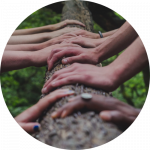
Follow Racial Justice activists, educators, organizations, and movements on social media.
Consider connecting with any of the people /organizations you learn about in the above resources. Here are more ideas to widen your circle of who you follow.
Pro Tip: check out who these organizations follow, quote, repost, and retweet to find more people/organizations to follow.
AfroLatin@forum | Twitter | Instagram | Facebook
The Conscious Kid | Twitter | Instagram | Facebook
Families Belong Together | Twitter | Instagram | Facebook
Social Justice Kids | Twitter | Instagram | Facebook
Right To Be | Twitter | Instagram | Facebook
Anti-Racism Daily | Twitter | Instagram
Indigenous Environmental Network | Twitter | Instagram | Facebook
The Center for Antiracism Research | Twitter | Instagram
Audre Lorde Project | Twitter | Instagram | Facebook
Black Women’s Blueprint | Twitter | Instagram | Facebook
The Gathering For Justice | Twitter | Instagram | Facebook
The Leadership Conference on Civil & Human Rights | Twitter | Instagram | Facebook
MPowerChange | Twitter | Instagram | Facebook
Muslim Girl | Twitter | Instagram | Facebook
NAACP | Twitter | Instagram | Facebook
National Domestic Workers Alliance | Twitter | Instagram | Facebook
The Refugee and Immigrant Center for Education and Legal Services | Twitter | Instagram | Facebook
SisterSong: Twitter | Instagram | Facebook
National Center for Transgender Equality | Twitter | Instagram | Facebook
Movement for Black Lives | Twitter | Instagram | Facebook
Dream Defenders | Twitter | Instagram | Facebook
Asian & Pacific Islander American Health Forum | Twitter | Instagram | Facebook
United We Dream | Twitter | Instagram | Facebook
The Philanthropy Initiative | Twitter
National Congress of American Indians | Twitter | Facebook
Antiracism Center | Twitter | Instagram | Facebook
Color Of Change | Twitter | Instagram | Facebook
Colorlines | Twitter | Instagram | Facebook
Equal Justice Initiative (EJI) | Twitter | Instagram | Facebook
Families Belong Together | Twitter | Instagram | Facebook
Showing Up for Racial Justice | Twitter | Instagram | Facebook
Learning for Justice (formerly Teaching Tolerance) | Twitter | Instagram |Facebook
Colours of Us | Twitter | Instagram | Facebook
Anti-Defamation League | Twitter | Instagram | Facebook
Nonprofit AF | Twitter | Instagram | Facebook
Define American | Twitter | Instagram | Facebook
AWARE-LA | Twitter | Instagram | Facebook
Privilege to Progress | Twitter | Instagram
18MillionRising | Twitter | Instagram | Facebook
Black Voters Matter | Twitter | Instagram | Facebook
Teaching While White | Twitter | Facebook
White Nonsense Roundup | Twitter | Instagram | Facebook
Conversations with White People: Talking about Race | Facebook
Race Forward | Twitter | Instagram | Facebook
Racial Equity Tools | Twitter | Facebook
1Hood Media | Twitter | Instagram | Facebook
White Awake | Twitter | Facebook
The Transgender Training Institute | Twitter | Instagram | Facebook

This can be the hardest part for people new to racial justice work. Engaging in racially mixed settings can trigger age-old power and privilege dynamics. The goal is to be a learner more than a knower, exactly the opposite of what dominant U.S. culture teaches us to be.
Here are some Engagement Tips to guide you:
- Enter the process to learn and bridge knowledge gaps.
- Enter the process to practice mindful social habits like the ones below.
- Work to stay engaged even when your mind and body start sending you signals to shrink or walk away.
- Ask clarifying questions.
- Acknowledge what you don’t know.
- Validate others by listening closely and believing the truth and importance of what they are sharing.
- Share airtime so that multiple perspectives are shared.
- Take space, Make space
- If you are generally quiet and/or from a marginalized group socialized to stay small, step up and practice speaking more.
- If you are a chatty extrovert and/or from a privileged group (male, white, heterosexual, able, etc.), spend more time listening and observing than talking.
- Notice your biases and judgments as they arise. These are gold for you to excavate your subconscious!
- Notice when you are uncomfortable. Reflect on why you’re uncomfortable and think about what you can do to build more emotional stamina in this area.
- Honor confidentiality. Though you can share what you are learning in general terms, do not repeat stories in a way that can be traced back to the person who shared it.
- Find a mentor within your own racial group to support and guide your growth.
If you are white, join a Showing Up For Racial Justice (SURJ) chapter in your area.
Google who’s who in your area by typing in ‘Racial Justice” or “Anti-Racist/m” + name of city/town, organization, or sector. A few website visits, emails, and phone calls later, you’ll likely have an idea of how to get on the mailing list of one or more organizations in your area who are addressing issues of power and privilege. Once you connect to one, it’s easy to connect to many!
Research racial justice speakers and see who might be coming to your local university, church, community center, or speaker series.
Take a course. Community Colleges and Adult Education Centers are a great place to find a course about social justice issues. Here are just a few to get you going:
Courses/Workshops to take on your own
White People Challenging Racism: Moving From Talk to Action
Visions Inc.
Vernā Myers Online Diversity and Inclusion Courses
Undoing Racism: The People’s Institute for Survival and Beyond
Cultural Somatics Training & Institute
The Center for Transformation and Change
National Conference for Community and Justice Anti-Racism Workshops
Crossroads Antiracism Organizing & Training
AWARE
AntiRacism I
Race and Cultural Diversity in American Life and History
Equity Learning Institute
Online Racial Equity Workshops through Eventbrite
Interactive opportunities to boost your knowledge
Whiteness Competency with Dr. Jacqueline Battalora and Michael Kilman
GroundWork USA: Climate Safe Neighborhoods
The National Native American Boarding School Healing Coalition
Project562
Social Justice Training Institute
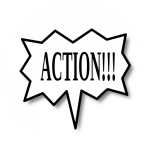
Though many people want to jump to action sooner instead of later, action without a vigorous self-education, self-reflection, and multiracial coalition can unexpectedly reproduce the very power and privilege dynamics we seek to interrupt. That said, sometimes acting immediately is called for. Welcome to the messy, imperfect world of challenging the status quo! Here are a few actions that you might consider:
- Invite friend(s), family, and/or colleagues to do the 21-Day Challenge with you.
- Prepare yourself to interrupt racial jokes. Click HERE for some advice about how.
- Interrupt the pattern of white silence by speaking openly with family, friends, and colleagues about what you’re doing and learning in the 21-Day Challenge.
- Invite friend(s), family, and/or colleagues to join you for one or more of your daily “to-do’s” for a low-threshold invitation into the work and introduction to the 21-Day Challenge.
- Find out if your school, workplace, or faith group has an Equity Committee. What can you learn from them? Are they open to new members? Join if you can. Support in other ways if you can’t.
- Find organizations such as The Privilege Institute and other non-profits doing racial justice work and support them through donating your time, money, and other resources.
- Find a 21-Day Challenge group in your region or sector and reach out to connect with, and perhaps co-create a region or sector specific 21-Day Challenge in the future. Google “21-Day Racial Equity Habit Building Challenge + your state, region, or sector”
- When the status quo is blatantly racist, disrupt it. No matter how big or small, put yourself out there to create change. No need to wait until you are comfortable disrupting; it may never get comfortable, though you will get better at managing discomfort. These actions are generally more successful when done in multiracial coalition. Examples from past participants include:
- Demanding administration change the name of a dodgeball team from “The Cottonpickers”
- Improving the representation of books in the library by raising funds and purchasing hundreds of new books
- Conducting an equity audit within the organization
- Creating learning communities to set goals, objectives, and action plans
- Disrupting inappropriate language by offering alternative language you yourself are learning
- Speaking, emailing, and posting about articles, blogs, movies, and this 21-Day Challenge that you find impactful.
- Share and Repost these on your social media with a prompt to “Read, Reflect, and Discuss” to prompt discussion with your community. Be sure to credit the original author!
Let people know you are not neutral!
![]() If you have young people in your life, integrate these resources to share and have conversations around. Choose three days of the challenge to read and have conversations with the young person/people in your life. Here are some great choices.
If you have young people in your life, integrate these resources to share and have conversations around. Choose three days of the challenge to read and have conversations with the young person/people in your life. Here are some great choices.
In the literature world there is a saying about books needing to be both windows and mirrors (Sims Bishop, R., 1990). If you are going to use multicultural books to introduce issues of social justice at home, you must be willing to engage in conversations that are also windows and mirrors so your children can understand both sides. Because there are multiple opportunities for multicultural books to increase stereotypes instead of eradicating them, it is a good idea to choose literature, always authentic, from reputable sources. Below are a few recommendations.
Youth Media Awards from the American Library Association This site is an excellent resource for award winning multicultural literature. Books are K-12.
Colours of Us Colours of Us contains over 500 recommended multicultural books organized by age level, race and ethnicity. In addition, this site offers collections such as, 37 Children’s Books to help talk about Racism and Discrimination and 70+ picture books about mixed races families. Books are K-12.
Cooperative Children's Book Center The CCBC of Madison maintains one of the most up to date book lists of books.
Raising an antiracist: A conversation with Ibram X. Kendi Dr Ibram X. Kendi and Dr. Robin DiAngelo talk about kids, parenting and racism.
Bibliographies include:
Peaceful Engagement: 25 Books for PreK-3 on Kindness, Empathy and Understanding
Never Too Old: Picture Books to Share with Older Children and Teens
Thick-skinned, Thin-skinned, The Skin I’m In: Books about Bullying, Teasing, Relational Aggression and School Violence
American Indians in Children’s Literature Debbie Reese is considered one of the foremost experts on Indigenous K-12 literature. Her blog includes not only recommended books but informative articles and book recommendations.
Selecting Anti-bias Children's Books (also applies to Young Adult Learners)
The best source for how to engage in a read aloud is Mem Fox. Fox has two essential tips: One, before starting the book make eye contact with each listener and continue the contact often; and Two, fall in love with the pause. A pause increases attention.
These are only a few recommendations. The idea is to be certain the literature you are using is authentic and recommended by experts in the community they represent.
Here are a few excellent books that will create great discussions at home. Break young adult and middle school books into 3-4 sections depending on reading level.
High School
The 57 Bus - A true story set in San Francisco, The 57 Bus follows two high school students caught on different sides of an unfortunate prank. Exploring LGBTQ+ identity and racism these very personal narratives draw the readers into the personal lives of two teens who both wish that day had never happened.
Stamped - Based on the bestselling Stamped from the Beginning by Dr. Ibram X Kendi and written by Jason Reynolds, the current National Ambassador for Young People’s Literature, Stamped is described as a journey through the racial history of the United States. Through facts and engaging narrative Reynolds brings history to life in a way that will engage our youth in a nonfiction book for the ages.
We are Not Free - The dark history of the internment of Japanese Americans is too often a minimal part of the educational curriculum. This fiction novel follows members of the same community in San Francisco on their journey through the camps. The interweaving of multiple stories, historical facts, and emotional journeys makes this book a remarkable account of untold stories that should be told.
The Firekeeper’s Daughter - In The Firekeeper’s Daughter, Boulley weaves a thrilling murder mystery with a coming to age talk of a strong Anishinaabe kwe (Ojibwe woman). Intertwined throughout the story are Anishinaabe language and culture as Daunis struggles with caring for a fragile mother, her role as a non-registered member of the Ojibwe community and a love story riddled with mystery.
Middle School
El Deafo - Have you ever wanted to have a superpower? Who hasn’t? But what if your superpower allows you to help others as well as possibly hurt them? In this amazing “slightly fictionalized” graphic novel, CeCe Bell weaves a powerful story of the search for true friendship.
Ghost - The first in the track series by award winning author Jason Reynolds, the story of Ghost is not just about finding oneself, but also finding one's “people.” Told through the development of a character that draws readers into pulling for Ghost, the team, and the coach, readers are taught to believe in the power of a team as family.
Sylvia & Aki - A true story of two young girls caught in a historical time of prejudice, racism and privilege. Aki and her family are removed from their farm and forced into a Japanese Internment Camp. Sylvia’s family rents the farm only to be embroiled in a fight to allow Sylvia to attend the white school down the street as opposed to the Mexican school further away. A story central to school desegregation through Mendez v Westminster and prior to Brown V BOE, Sylvia and Aki highlight the strength of our youth.
The Door of No Return - The Door of No Return depicts well the harrowing violence and tragedy of the Atlantic slave trade. Readers travel from a peaceful community in the Asante Kingdom of 1860 to the “door of no return” in Cape Coast Castle.
Picture Books
The Bell Rang - A gripping story of a week in the lives of enslaved Africans on a southern plantation. Day by day through emotional illustrations readers follow a sister’s heart wrenching wait for the dogs to bark. Will today be the day?
Shin-Chi’s Canoe - Imagine young children who cry when their parents leave for an hour, or a day. And then imagine being six and put on a cattle car to a school far from home. The unconscionable history of US Government Boarding schools for members of First Nations is told in Shin-Chi’’s Canoe. Gentle and yet honest, readers will learn to build empathy and recognize inequities in history so we never repeat them.
Red: A Crayon’s Story - Why must we match? Why must what is inside us be reflected on the outside? This simple and yet moving and complex book explores complex issues of identity that make sense even to the youngest. A must read to discuss compassion and understanding.
The Name Jar - Names are ours. But when our name is something others can’t pronounce, is it ok for them to change it to make it “easier” for them? The Name Jar is a must read in every classroom as it celebrates the joy of our name, our families, our journey through life.
Unspeakable - traces the history of African Americans in Tulsa’s Greenwood district and chronicles the devastation that occurred in 1921 when a white mob attacked the Black community.

Reflecting and Journaling is a crucial piece of the challenge. Plan to take time everyday to reflect on what you chose to do, what you’re learning, and how you are feeling. Difficult emotions such as shame and anger, though uncomfortable to feel, can guide you to deeper self-awareness about how power and privilege impacts you and the people in your life. At the very least, use the “Reflect” space on the reflecting journal tool.
Use our tracking tool to stay on track and be able to reflect back at the end.(Tip: diversify your habits by doing some of each.)
 Create a Soundtrack4Justice playlist that fuels you and/or can serve as a conversation starter with people of all ages.
Create a Soundtrack4Justice playlist that fuels you and/or can serve as a conversation starter with people of all ages.
You can find ours on Spotify, Youtube, Apple Music, or see individual songs below:
El Apagon / Bad Bunny
El Pueblo Unido / Sergio Ortega
Afilando los Cuchillos / Residente, iLe & Bad Bunny
Pray / Flobots
The Search/NF
Sunshine / Latto
Count Me Out / Kendrick Lamar
My Stress / NF
Bigger Picture / Lil Baby
My Skin / Lizzo
New America - Marina
No Justice No Peace - Bobby Hustle, Asha D Pipo Ti
It’s a good day (to fight the system) / Shungudzo
Emma Stevens - Blackbird by The Beatles sung in Mi'kmaq Live at CBU
Nina Simone - I Wish I Knew How It Would Feel to Be Free (Audio)
Kalolin Johnson - We Shall Remain (It Wasn't Taken Away)
Sister Sledge - We Are Family (Official Music Video)
Ain’t Got No, I Got Life / Nina Simone
Baltimore / Nina Simone
Be Free / J Cole
Blended Family / Alicia Keys
Blue Bucket of Gold/Gallant X Sufjan Stevens
Born This Way / Lady Gaga
Brave / Sara Bareilles
Call Me By Your Name / Lil Nas X
Colors in Bloom / Lex Allen ft. Taj Raiden
Fight the Power / Public Enemy
Fight Song / Rachel Platten
Formation / Beyonce
For The Kids / Homeboy Sandman
Four Women / Nina Simone
Give Your Hands to Struggle / Sweet Honey in the Rock
Get Up, Stand Up / Bob Marley
Good As Hell / Lizzo
Good Way / Frank Waln w/ Gunner Jules & Rollie Raps
Hear My Cry / Frank Waln w/ Cody Blackbird
House Of A Thousand Guitars / Bruce Springsteen
Hijabi / Mona Hayder
If It’s Magic / Stevie Wonder
Industry Baby / Lil Nas X & Jack Harlow
It’s a good day (to fight the system) / Shungudzo
Keep Your Head Up / Tupac
Love’s In Need of Love Today / Stevie Wonder
Living for the City / Stevie Wonder
Mercedes Benz / Janis Joplin
My Country ‘Tis Of Thy People You’re Dying / Buffy Sainte Marie
Ne Me Quitte Pas / Nina Simone
People Get Ready / Curtis Mayfield and The Impressions
Rich Girl / Nina Simone
Roar / Katy Perry
Same As It Ever Was/Michael Franti & Spearhead
Same Love / Macklemore & Ryan Lewis
Save Me / Nina Simone
Slow Up / Jacob Banks
Stay Human / Michael Franti & Spearhead
Super Rich Kids / Frank Ocean
Strength, Courage & Wisdom / India Arie
The 10 Stop and Frisk Commandments / Jasiri X
The Colour in Anything / James Blake
Try / Colbie Caillat
We The People / Tribe Called Quest
Try Everything / Shakira
Where Is The Love / Black Eyed Peas
White Privilege / Mackelmore
White Privilege II / Macklemore
Whitey on the Moon / Gil Scott-Heron
Stand 4 What / Nick Cannon
This Is America / Childish Gambino
To Be Young Gifted and Black, Nina Simone
Ultra Black / Nas
![]()
In 2022, the US is 500 years into a struggle to create a country claiming to be rooted in freedom yet still riddled with unhealed wounds, unkept promises, and barriers to access for millions. As we work towards a more just future, remembering and building on the legacy of these legends is both strategic and inspiring. Here are just a few. Come back for updated challenges and #MooreLegends.
bell hooks (1952-2021) activist and prolific author whose work focusing on gender and race pushed the “feminsim” movement beyond its white, middle-class roots to uplift stories of Black and working class women.
Mary Brave Bird (1954-2013) aka Mary Crow Dog, Lakota activist, author, educator and survivor of the Indian Boarding School Movement system of deculturalization and abuse who dedicated her life to the American Indian Movement (AIM) and told her story in her memoir, Lakota Woman.
Marsha P. Johnson (1945-1992) a Black trans woman, Marsha “Pay it no mind” Johnson was central to the 1960s LGBTQIA+ movement in general and the Stonewall riots specifically.
Dolores Huerta (1930 - still here!) an agricultural labor leader and civil rights activist who, along with Cesar Chavez, co-founded what went on to be the United Farm Workers Association, while also fiercely challenging sexism within the movement
Cesar Chavez (1927 - 1993) a civil rights activist, Latino, and farm labor leader and hero. He co-founded the National Farm Workers Association as a crusader for environmental, worker, and consumer rights.
James Loewen (1942-2021) sociologist, historian and author whose works, including Lies My Teacher Told Me changed the way we think about learning history.
John Lewis (1940 - 2020) civil rights activist who chaired SNCC, led Selma’s Pettus Bridge march, and participated in lunch counter sit-ins and Freedom Rides, before becoming a 17-term congressional leader, and author of the NYT Op-Ed commonly referred to as “Good Trouble.”
Yuri Kochiyama (1921 - 2014) activist for a wide range of initiatives including immigrant rights, Black liberation, anti war movement, Asian American rights, and ethnic studies, all sparked by the unjust treatment she and her family endured as part of the Japanese concentration camp abuse during WWII.
Anne McCarty Braden (1924 - 2006) civil rights activist, journalist, and educator who challenged racist real estate practices, rallied white southerners to support the Civil Rights Movement, and worked for cross-racial solidarity in the environmental, labor, women's, and anti-nuclear movements.

